BIO-214 #5 Phylogenetics & Taxonomy
1/42
There's no tags or description
Looks like no tags are added yet.
Name | Mastery | Learn | Test | Matching | Spaced |
|---|
No study sessions yet.
43 Terms
What is phelogeny?
The evolutionary history & relationship of an organism/group of organisms
Describes the organism’s relationships
From which organisms it may have evolved
Which species it is most closely related
Provides information on shared ancestry, NOT on how organisms are similar/different
What is a phelogenetic tree used for?
Shows the evolutionary pathways & connects among organisms
Diagram used to reflect evolutionary relationships among organisms/group of organisms
Map of evolutionary history
What does it mean for a phelogenetic tree to be “rooted” or “unrooted”?
Rooted: There is a single ancestral lineage to which all organisms represented in the diagram relate
Unrooted: do not show a common ancestor, but show relationships among species
What is a branch point in a phelogenetic tree?
Node on the phelogenetic tree where a single lineage splits into distinct new ones
What is a basal taxon on a phelogenetic tree?
Branch on a phylogenetic tree that has not diverged significantly/remains unbranched from the root ancestor
What are sister taxa?
two line lineages that diver from the same branch point
What is a polytomy?
A branch with more than two lineages & serves to illustrate where scientists have not definitely determined all of the relationships
Does the rotation at branch points change tine information on the phelogenetic tree?
No
Each taxon’s evolution from the branch point was independently of each other
What is the field of systemics?
Field that scientists use to organize & classify organisms based on evolutionary relationships
Use data from:
Fossils
Studying the body part structures
Molecules an organism uses
DNA analysis
What are the misconceptions/limitations of the phylogenetic tree?
People make assumptions that more closely related organisms look more alike
False: if two closely related lineages evolved under significantly varied habitats, then the two groups will appear differently
Branches do not account for the length of time, only evolutionary ordered
A branch length does not mean more time has passed or not
What is a clade?
Shows the relationships between taxa, but are not formal relationships (only shows related species) because they share the same common ancestor
What is taxonomy?
Science of classifying organisms
What is a hierachical system?
Organization from larger to smaller, more specific categories
Who was Carl Linnaeus?
What model did he use?
How did scientists divide organisms after the common beginning of all life?
Inventor of the taxonomic classification system (Linnaean system)
Swedish botanist, zoologist, & physician
Used a hierarchical model
Starts off at the point of origin
Groups become more specific until 1 branch ends as a single species
Divided into three large categories (domains)
Bacteria
Archaea
Eukarya
What is the order of the hierachical classification?
Domain → Kingdom → phylum → class → order → family → genus → species
What is a taxon?
The name at each level in the taxonomic classification system
Phylum:Chordata
Class: Mamalia
Order: Carnivora
Family: Canidae
Genus: Canis
Species: Lupis
What is the bionomical nomenclature?
System of two-part scientific names for an organism
Genus capitalized, species italized
Canis lupus → C. lupis
What are subspecies?
Members of the same species that are capable of mating and reproducing viable offspring
Separated due to geographic or behavioral isolation, or other factors
What two types of evidence are used for phylogentic evolutionary investigations?
Morphologic (form & function)
Genetic
What are homologous structures?
Structures that overlap morphologically (in form) & genetically
Stem from developmental similarities that are based on evolution/embryonic origin
Ex: bones in bat & bird wings
Grouping of bones, not just a single bone
More complex the feature, the more likely any kind of overlap is due to a common evolutionary past
What are analogous structures?
Similar environmental pressures & natural selection produce similar adaptations in organisms from different evolutionary lineages
Insects & bats
Both use wings to fly, but the wing structure & embryonic origin is different.
What is molecular systematics?
What are the limitations of molecular systematics?
technique that uses molecular evidence to identify phylogenetic relationships
Limitations
Mutations might cause mishaps when reading DNA sequences
distantly related organisms may randomly share a high percentage of bases in the same locations → They SEEM to be closely related, but are not
What are cladistics?
System that sorts organisms with homologous traits into clades
groups of organisms that descended from a single ancestor
What are the 3 types of clades?
Monophyletic group
Paraphyletic
Polyphyletic
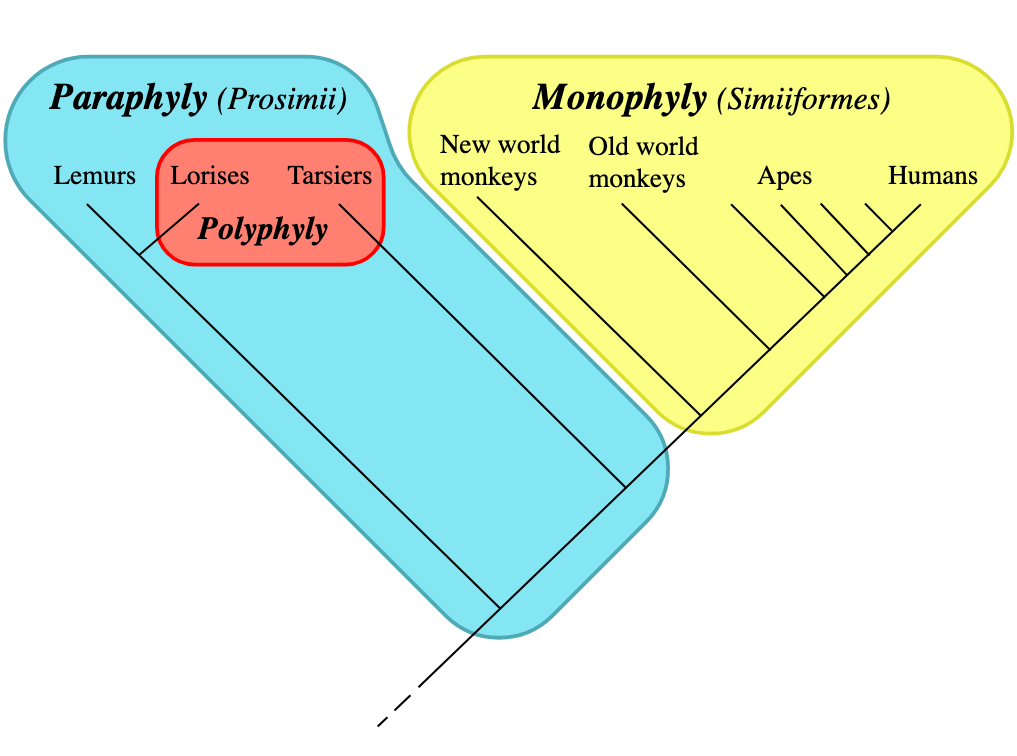
What is a monophyletic group?
group of organisms that evolved from a common ancestor
Must stem from a single point on the tree
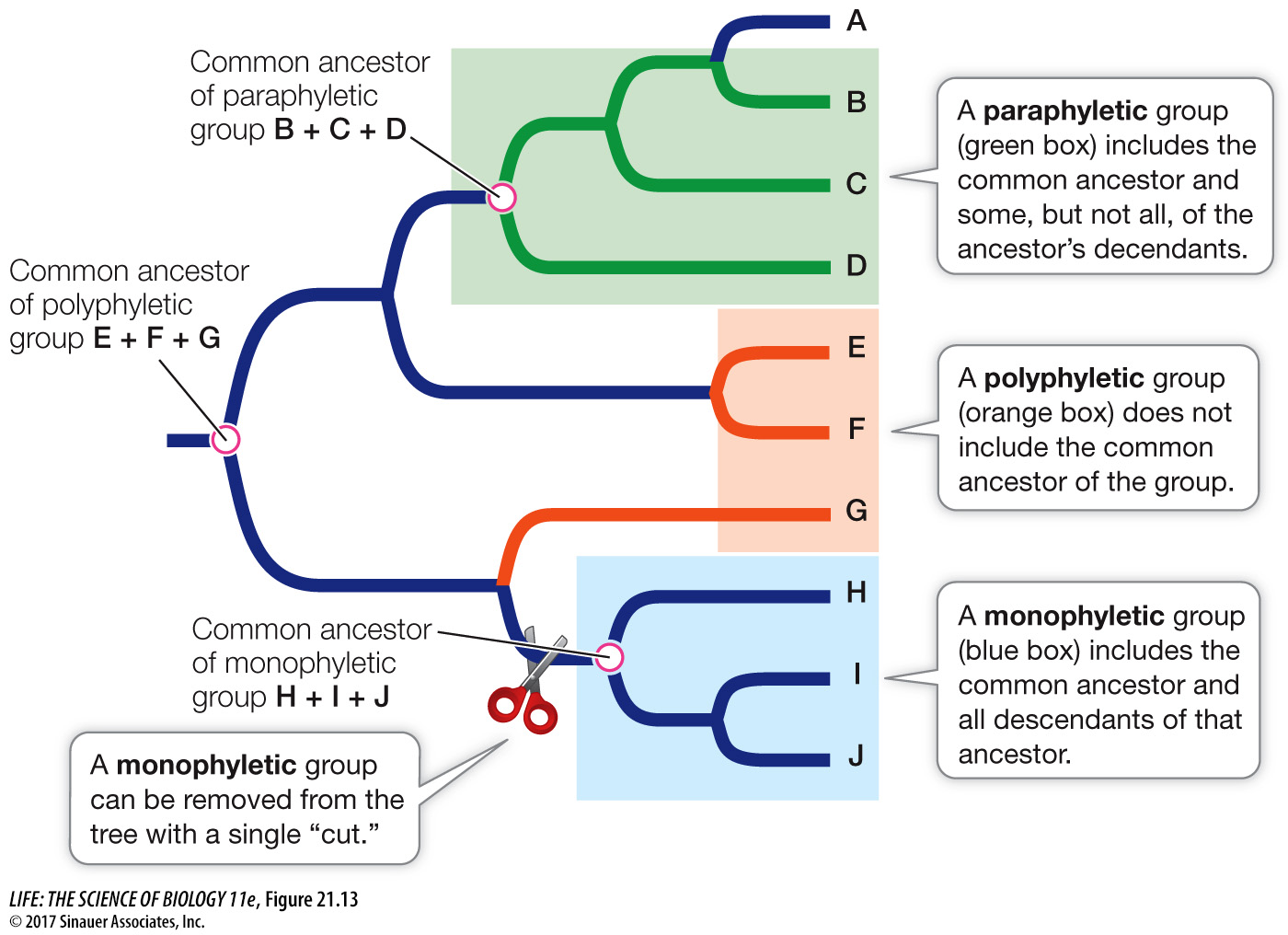
What is a paraphyletic group?
Some, but not all of the descendants originated from a common ancestral species
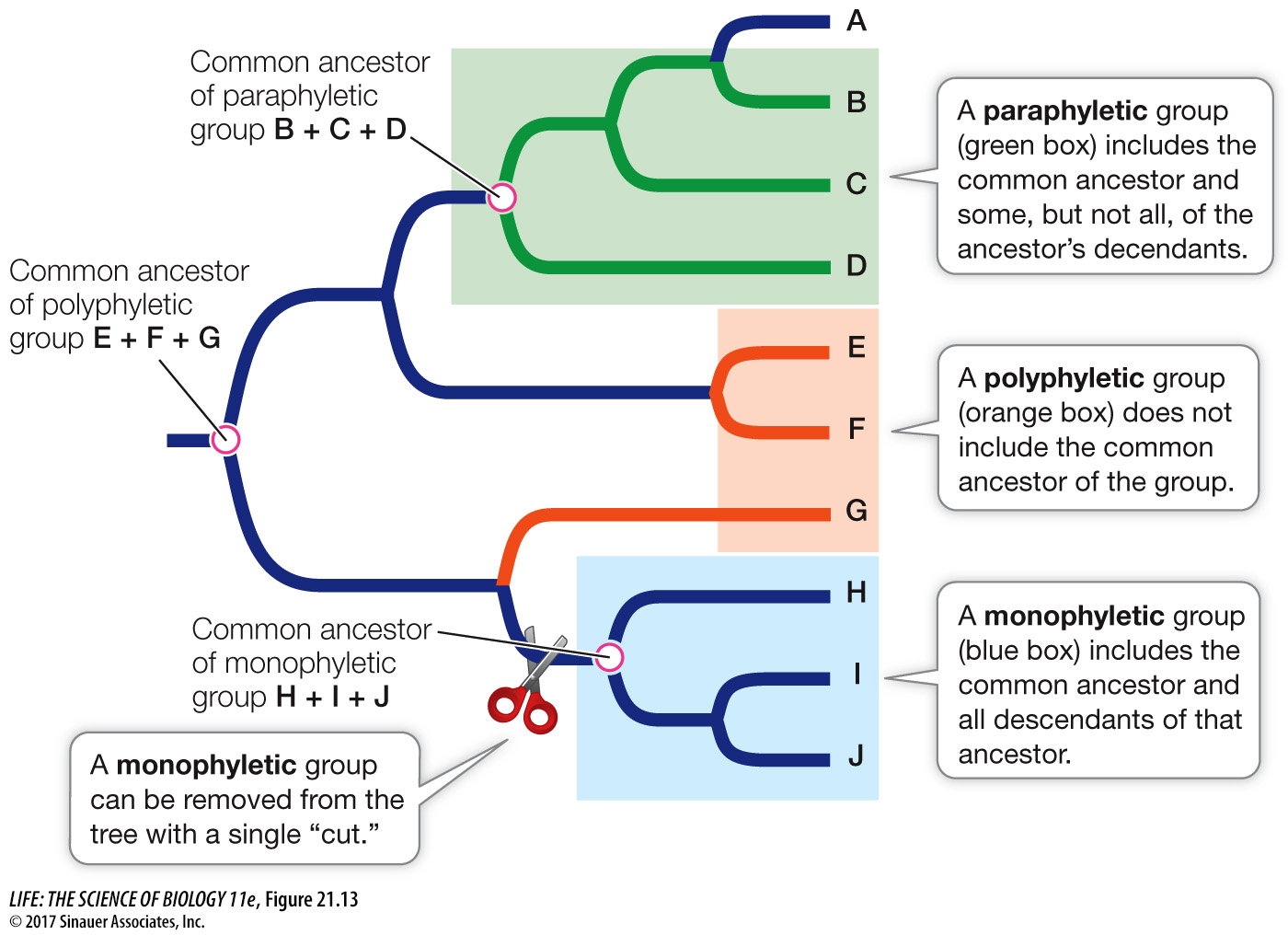
What is a polyphyletic group?
Clade that includes distantly related species, but does not include their most recent common ancestor
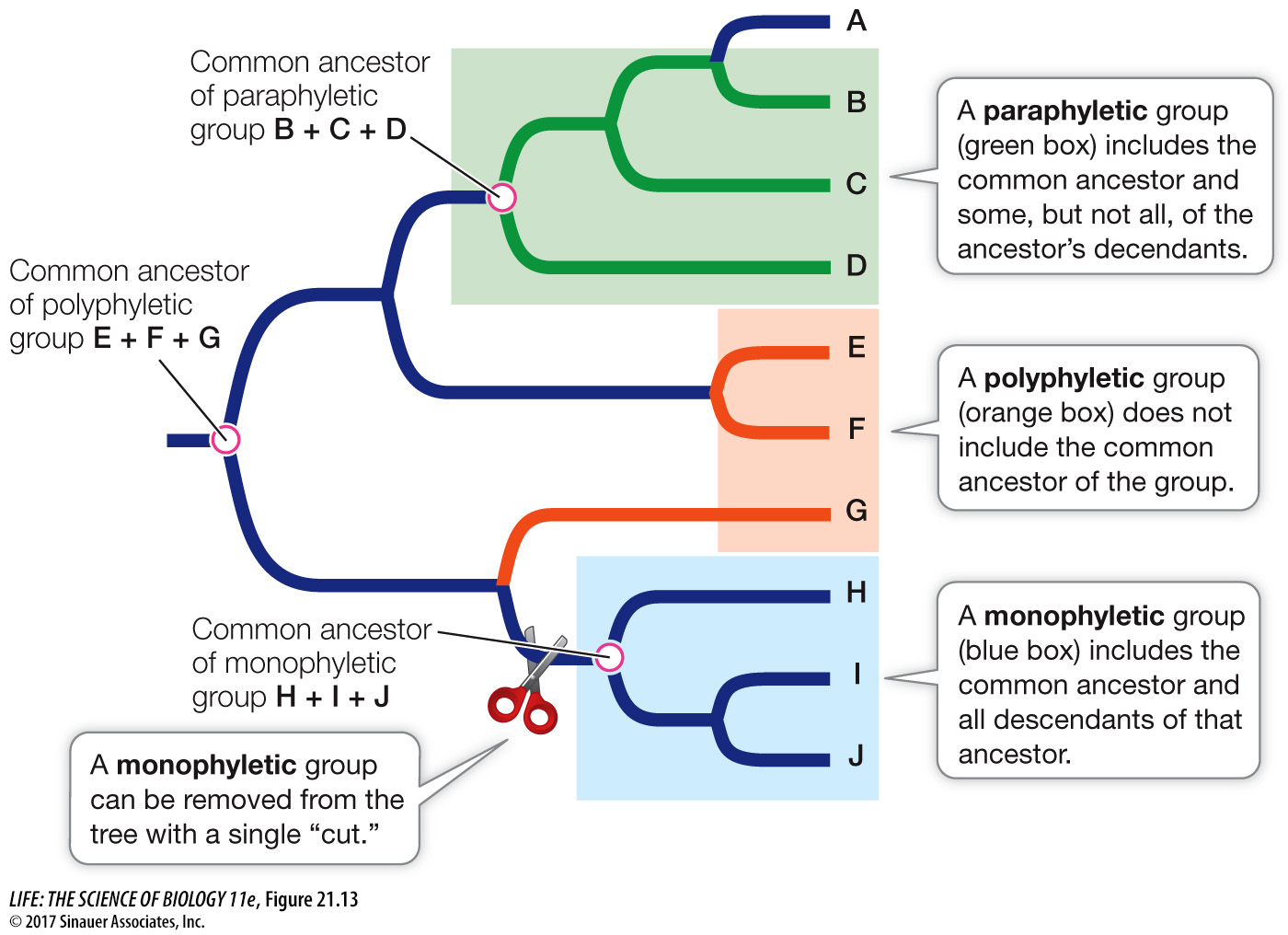
What does the phrase “descent with modification” mean?
What pattern is seen in the phylogentic tree of life?
Organisms evolve from common ancestors and then diversify
related organisms have many of the same characteristics & genetic codes, changes occur
Pattern
A change occurs in an organism’s genetic makeup → leads to a new trait that becomes prevalent in the group
Many organisms descend from this point & have this trait
New variations continue to arise
Some are adaptive & persistent, leading to new traits
With new traits, a new branch point is determined (go back to step 1 & repeat)
What is a shared ancestral character?
A characteristic that is found in the ancestor of a group
All the organisms in the taxon or clade have that trait
What is a shared derived character?
Characteristic on a phylogenetic tree that only a certain clade of organisms share
Only some of the organisms have the characteristic
The characteristic derived at some point but DOES NOT include all the ancestors in the tree
What is maximum parsimony?
Applying the simplest, most obvious way with the least number of steps
Who created the first phylogenetic tree?
What features did this tree have?
Charles Darwin
His phylogenetic tree served as a prototype for subsequent studies\
Features
Single trunk: represents a common ancestor
Branches: represents the divergence of species from this ancestor
What were some limitations to the Classic Model/Darwinian Phylogenetic Tree?
Assumes that species evolve clonally
asexual reproduction
species produce offspring themselves
Reality: eukaryotes reproduce sexually
Random mutations are the only cause of genetic variety
Laws of Mendelian genetics explain that mutations within a species causes genetic variety
Did not consider the concept of genes transferring between unrelated species
What is Horizontal Gene Transfer (HGT)/Lateral Gene Transfer?
How does HGT affect the classical tree model?
In which organisms is HGT more prevalent?
Transfer of genes between unrelated species
May play a major role in evolution
introduces genetic material from one species to another by mechanisms other than the vertical transmission from parents to offspring → influences phenotypes
Complicates the simple tree model
More prevalent in prokaryotes
HGT & mutations are sources of genetic variation
What do genome fusion theories propose?
How is it tied to the endosymbotic theory?
Genome fusion led to the evolution of the first eukaryotic cells via the endosymbiosis of prokaryotic species
Endosymbiotic theory
One prokaryotic species was taken inside another species’ cytoplasm → fusion of two prokaryotic genomes
Species may have been from Archaea and Bacteria
Why are the evolutionary orgins of nuclear & mitochondrial DNA different?
Mitochondrial DNA
derived from the bacteria’s circular genomes that ancient prokaryotic cells engulfed
smallest chromosome
only inherited from the maternal side
Nuclear DNA/ eukaryotic nucleus
Prokaryotic cells produced an additional membrane that surrounded the bacterial chromosome
No evidence of a nucleolus or nuclear pore tho
What is the nucleus-first hypothesis?
What is the mitochondria-first hypothesis?
What is the eukaryote-first hypothesis?
Nucleus-first hypothesis
nucleus evolved in prokaryotes first → fusion of the new eukaryote with bacteria that became the mitochondria
Mitochondria-first hypothesis
mitochondria were first established in a prokaryotic host → acquired a nucleus (by fusion or other mechanisms) to become the first eukaryotic cell
Eukaryote-first
prokaryotes actually evolved from eukaryotes by losing genes & complexity (sounds sus)
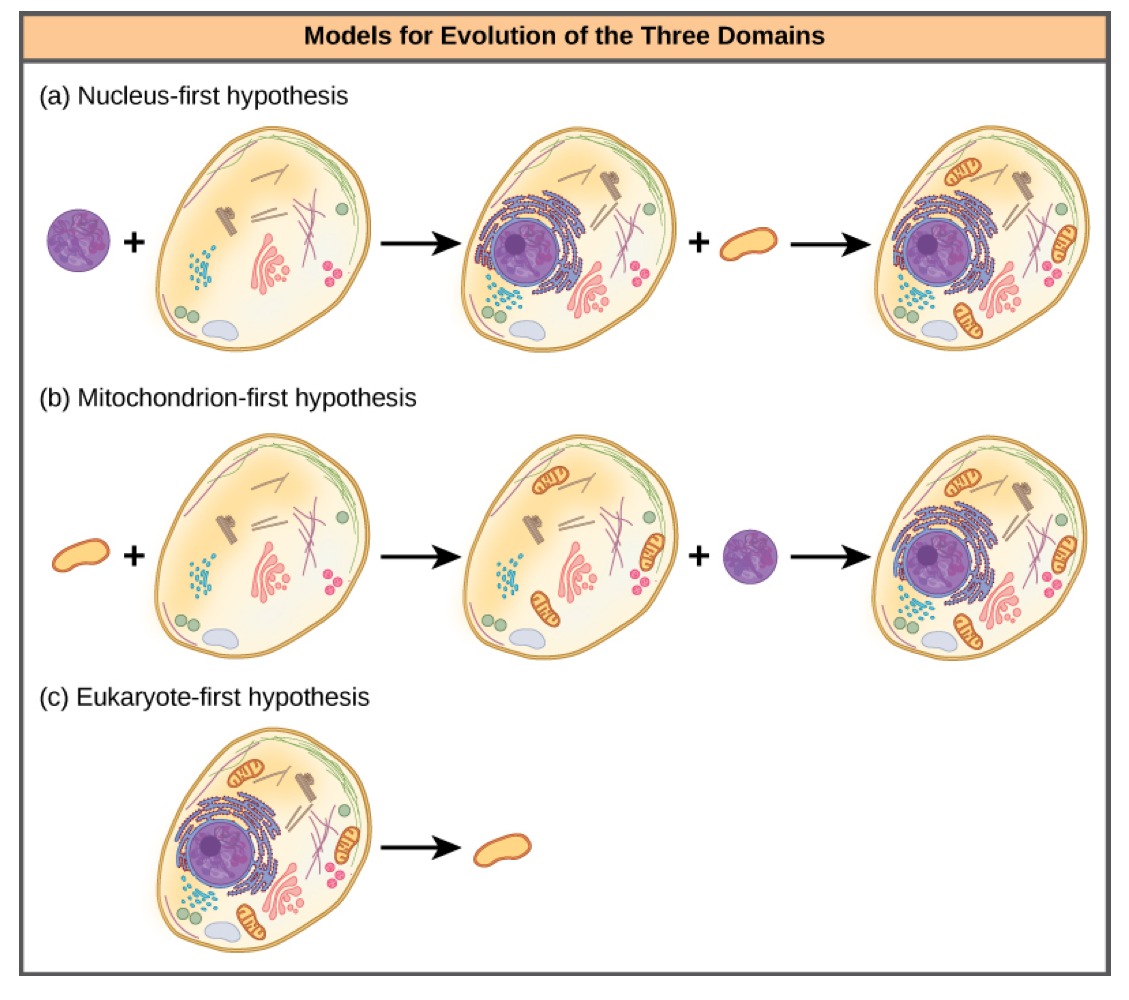
PROKARYOTIC mechanisms, mode of transmission, & examples?
Mechanism 1: Transformation
Mode of Transmission: Bacteria uptake naked DNA
Ex: many prokaryotes
Mechanism 2: Transduction
Mode of Transmission: a virus transfers the genes
Ex: Bacteria
Mechanism 3: Conjugation
Mode of Transmission: A hollow tube, or pilus, transfers genes between organisms
Ex: many prokaryotes
Mechanism 4: Gene Transfer Agents
Mode of Transmission: transfer random genomic segments from one prokaryotic species to another
Ex: purple non-sulfur bacteria
Most likely derived from bacteriophage DNA in
How did scientists find the first Gene Transfer Agents (GTAs)?
GTS were derived from bacteriophage DNA inserted into a prokayote that lost the ability to produce new bacteriophages
GTAs carry random DNA pieces from one organism to another
GTAs & viruses are effecient HGT (horizontal gene transfer) vehicles with a major impact on prokaryotic evolution
EUKARYOTIC mechanism, mode of transmission, & examples?
Mechanism 1: From Food organisms
Mode of Transmission: transfer of fungal genes by HGT
Ex: aphid
Aphids make carotenoids on their own
Mechanism 2: Jumping genes 🙂
Mode of Transmission: transposons/jumping genes
Ex: rice & millet plants
Mechanism 3: Epiphytes/Parasites
Mode of Transmission: unknown
Ex: Yew tree fungi
fungi species feed on yew trees
Mechanism 4: Viral infections
How does HGT affect the classic “tree of life” model?
Eukaryotes evolved from a pool of many species that were sharing genes by HGT mechanisms
Web/network, rather than a tree with a single origin
What is the “web of life” model?
Phylogenetic model that attempts to incorporate the effects of horizontal gene transfer on evolution
Similar to the ficus tree model (multiple trunks represent multiple evolutionary origins)
What is the “ring of life” model?
Phylogenetic tree model where all three domains of life evolved froma pool primitive prokaryotes
Takes into consideration HGT AND genomic fusion into account